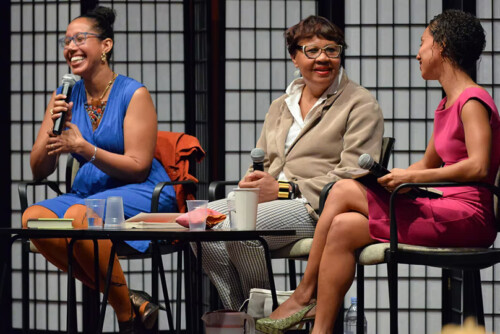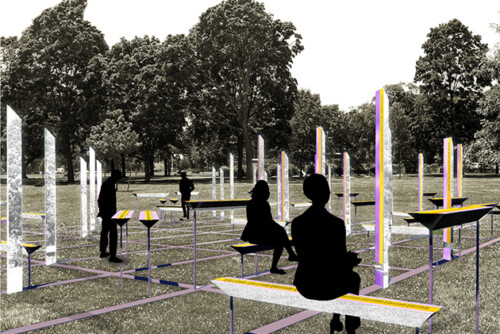During the past two years, I have been engaged in a multidisciplinary ethnographic project funded under the Ford Foundation initiative, “Youth Sexuality, Health, and Rights in the United States.” The project examines the structural climate of youth sexuality and sexual health through a political economic lens, focusing specifically on three different modalities of sexual commerce among young people in Detroit, Michigan. These different modalities correspond to three distinct communities: homeless or marginally-housed African American and Latina transgender women; African American and Latina young women engaged in street-based sex work; and Latino youth involved in gangs. Three community-based organizations are closely collaborating with the investigative team 1 as salaried community partners in all aspects of the project, including decisions and logistics regarding research, budgets, fieldwork implementation, interpretation, and ways of addressing the structural or policy climate of Detroit through interventions, policy advocacy, activism, and strategic communications. These three organizations are: the Ruth Ellis Center; Alternatives for Girls; and the Detroit Hispanic Development Corporation. To date, we have conducted ethnographic observations with each of the communities of interest, 60 in-depth interviews, 30 life histories, and 200 quantitative surveys, with the aim of understanding some of the broad trends or intersections across our diverse set of constituencies that suggest ways in which the structural context of Detroit shapes youth sexuality, sexual commerce, and vulnerability.
Detroit is often ascribed a particular identity in neoliberal thought and critique. From all sides of the debate, the city stands as a quintessential example of neoliberalism gone wrong, provoking national commentaries, artistic interpretations, and even a new tourist market aimed at providing vicarious glimpses of the postindustrial “urban ruins.” A photo essay in a recent issue of Time magazine, entitled “Detroit’s Beautiful, Horrible Decline,” encapsulates many of the features of the dominant narratives of Detroit in the contemporary era. Based on an acclaimed book by French photographers Yves Marchand and Romain Meffre, “The Ruins of Detroit” presents stunning pictures of structural decay and abandonment, including collapsing and dilapidated monuments, such as the Lee Plaza Hotel, the United Artists Theater, and the Michigan Central Station, which are presented as a sort of biblical disaster—an apocalypse from which all of Detroit’s citizens have apparently fled. The abandoned factories, vacant schools, and decaying hotels are used to remind the viewer of the fragility of the modern world and to stand as a warning of an impending national decline. Once a national symbol of modernity and industrial progress, Detroit has come to represent the potential for urban decline and the omnipresent dangers of deindustrialization, globalization, and outsourcing. No matter where an individual positions herself in relation to neoliberal politics or economic principles, Detroit is a symbol of economic and social calamity in the postindustrial era. 2
One challenge of our research is to interrogate the extent to which the position of Detroit in the global neoliberal imaginary—the set of discourses and practices that compose both the tenets of neoliberal principles and the multidisciplinary critiques of these principles—is linked to the subjectivity and daily reality of young people on the ground. In particular, we are interested in the ways that these neoliberal narratives of Detroit’s decline are received, understood, and embodied by young people who already bear the brunt of social stigma as a result of violations of normative expectations of gender and sexuality. Analytically, we believe that this approach helps to bring into relief the ways that sexuality is shaped by neoliberal discourse, and in turn, how neoliberal discourses of Detroit’s decline might have particular linkages to sexuality and sexual commerce in the city.
These reflections are ongoing in our analysis, and we are just beginning our interpretations of these linkages, but our analysis thus far is motivated by the desire to critically engage the effects of neoliberal principles on Detroiters. We work with the theoretical assumption that these effects are not only material/economic (i.e., as in the policies of market liberalization permitting outsourcing by automobile companies), but also fundamentally symbolic and cultural. We believe we are witnessing some of the reverberations of these cultural effects of neoliberalism when we talk to young people, who are often wise interpreters of the national narratives that circulate about their city, and are well aware of what Detroit stands for in international narratives of postindustrial collapse.
For example, we believe we are witnessing some effects of neoliberal narratives about Detroit when young Detroiters—from across all of the diverse groups included in our study—articulate a deep sense of shame about their city or their neighborhoods. Consistent with globally circulating representations of Detroit, when we asked young people to tell us about their communities, they often referred to Detroit as a city in decline, as a place that has fallen from “one of the richest cities in the world” to a “ruined” landscape that is decaying and dilapidated. Young people most often used negative terms to describe their communities, such as “abandoned,” “burned out,” “filthy,” or “ghetto.” While these narratives may appear to perfectly recapitulate the dominant national narratives of Detroit’s decline, young people also describe in eloquent terms the ways that the “spoiled status” of the city affects their lives and well-being. “Angela” (a pseudonym) is a 19-year-old Latina participant from Southwest Detroit, and provides one vivid example. In her interview, she repeatedly lamented the “slum” and “ghetto” qualities of the city, and then described what we interpret as her desire to disavow those stigmatizing qualities, to convince us (or others?) that she is not merely a reflection of that decline. Her words provide a useful illustration of this theme:
[It’s] like a dirty life, you know. And it’s nasty, you know, to live with people that don’t care…because it makes the whole city look bad, because you have so many people that just don’t care, don’t take care of their stuff. It just makes us look bad, like, you just hear people, like, ‘Where you from, Detroit? Oh, it’s so bad over there.’ You know, to hear people say that about your own city and where it’s from, it’s like, I’m not like that.
Similarly, “Joanna,” 19, a Latina in Southwest Detroit, explained that the burned-out houses in her neighborhood “makes it less valuable. It makes the community look a lot worse. It makes us look a lot worse cause it looks like we’re doing it. Like, you know, we have some innocent people out there.”
Analytically, we interpret Angela’s statement, “I’m not like that,” and Joanna’s reference to “innocent people”—as well as many similar articulations in the research—as discursive strategies for disavowing or resisting the dominant narratives of Detroit. The fact that young people use these strategies demonstrates the structural logic behind their operation; these Detroiters are aware that they may suffer further because of the negative perceptions of outsiders (or, perhaps, the nation? the government? the authorities?), who might believe that “innocents” like them are responsible for the decline of the city. We often detected a sense of irony in these narratives, instances in which one senses that the interviewee is trying to articulate a question: “You mean, in addition to losing our jobs and facing all the economic challenges we face, you are going to blame us for this disaster?” As young people grappled with this question, they also expressed a deep fear about what it meant for their future. “I’m afraid I’m going to be stuck here forever” was a phrase that reverberated through our interviews, as people described how the city’s “decline” shaped their daily challenges, prospects for advancement, or possibilities for “escaping” the city, moving away, or “making it” in the suburbs.
In some of our work on these issues, we have described these processes as expressions of spatial stigma, which Detroiters must manage. 3 We believe the concept is useful for understanding the effect of national narratives of Detroit’s decay on the politics of space in the city, as well as for developing a theoretical framework for understanding the intersection of neoliberalism and social inequalities. A significant amount of health and social research has considered the way that places contribute to the health, well-being, and life chances of their residents. 4 The bulk of this research has focused on the vulnerabilities and resources that are contained within the bounded spaces of neighborhoods and communities. Places are understood as geographic zones of material resources or economic configurations that shape the social and health conditions of populations. Only recently have scholars begun to consider how such material configurations interact with the symbolic dimensions of place to further affect well-being. 5 While spaces can be defined by their geographic boundaries and characteristics, places are comprised not only of people and objects, but also symbolic representations, which in the context of a hierarchical society, often become expressions of social distinction. 6 As spatial representations of deeply rooted inequalities, places carry powerful social meanings that can be embodied by their residents. Drawing on both social and health research, as well as our ethnographic data, we argue that these symbolic dimensions of place are an understudied pathway that links social geographies to unequal health, well-being, and life chances.
Stigma theory provides a framework for conceptualizing the various ways that the organization of space influences health and well-being. In thinking about spatial stigma in Detroit, we find it important to examine the impact of the city’s “decline,” not only in relation to its political-economic context, but also in relation to the symbolic forces and cultural logics of neoliberalism, which function to shift blame for the collapse on to particular individuals and groups. These symbolic processes shape the experiences of those who reside in or relocate from vilified and degraded locales, who may be marked by a stigma of place that influences their identity formation, their access to resources, and their social or geographic mobility. Further, the discursive and symbolic processes that undergird spatial stigma function in relation to other axes of social inequality, such as those associated with race, class, gender, and sexuality. Thus, the effects of spatial stigma on a white middle-class gay man from the Detroit suburbs are likely quite distinct from those experienced by a black transgender woman from Highland Park. Because our ongoing work focuses on young people who are marginalized for their race, gender, sexuality, and/or gender identity, our analyses of spatial stigma have also sought to explore how young people who already experience rather intense stigma for other characteristics are simultaneously affected by spatial stigma. As with all of our research, our primary purpose is to think critically and structurally about the conditions of health and social inequality for young people in Detroit, and to leverage research toward policy changes and social transformations that could improve such conditions.
To read more about the Detroit Youth Passages project, visit the project website.
- Key authors of the Photovoice project are: Louis F Graham (Department of Public Health, University of Massachusetts Amherst, Amherst, Massachusetts), Armando Matiz (Department of Health Behavior and Health Education, University of Michigan School of Public Health, Ann Arbor, Michigan), William Lopez (Department of Health Behavior and Health Education, University of Michigan School of Public Health, Ann Arbor, Michigan), Alana Gracey (Outreach & Education Services, Alternatives For Girls, Detroit, Michigan), Rachel Snow (Department of Health Behavior and Health Education, University of Michigan School of Public Health, Ann Arbor, Michigan), Mark B Padilla (Global and Sociocultural Studies, School of International and Public Affairs, Florida International University, Miami, Florida). In addition, we would like to acknowledge support from: Angela Reyes (DHDC), Deena Policicchio (AFG), Joshua Trayler, Jack Tocco, Monica Hudson, Xiomara Torres, and Brittny. Please see the full Detroit Youth Passages team at: http://detroityouthpassages.org.[↑]
- Yves Marchand and Romain Meffre, The Ruins of Detroit, (London: Steidl, 2011).[↑]
- Keene, Danya and Padilla, Mark. “Race, Class and the Stigma of Place: Moving to ‘Opportunity’ in Eastern Iowa.” (2011). Health and Place 16(6): 1216-1223.[↑]
- S. Macintyre, A. Ellaway, and S. Cummins, “Place effects on health: how can we conceptualise, operationalise and measure them?” Social Science & Medicine 55(2002): 125-139; A. V. Diez Roux and C. Mair, “Neighborhoods and health,” Annals of the New York Academy of Sciences 1186(2010): 125-145.[↑]
- S. Cummins, S. Curtis, A. V. Diez-Roux, and S. Macintyre, “Understanding and representing ‘place’ in health research: A relational approach,” Social Science & Medicine 65(2007): 1825-1838; S. Wakefield and C. McMullan, “Healing in places of decline: (re)imagining everyday landscapes in Hamilton, Ontario,” Health & Place 11(2005): 299-312; J. Popay, C. Thomas, G. Williams, S. Bennett, A. Gatrell, and L. Bostock, “A proper place to live: health inequalities, agency and the normative dimensions of space,” Social Science & Medicine 57(2003): 55-69.[↑]
- T. F. Gieryn, “A Space for Place in Sociology,” Annual Review of Sociology 26(2000): 463-496; P. Bourdieu, “Site Effects,” The Weight of the World, P. Bourdieu, ed., (Stanford: Stanford U P, 1999) 123-130.[↑]



